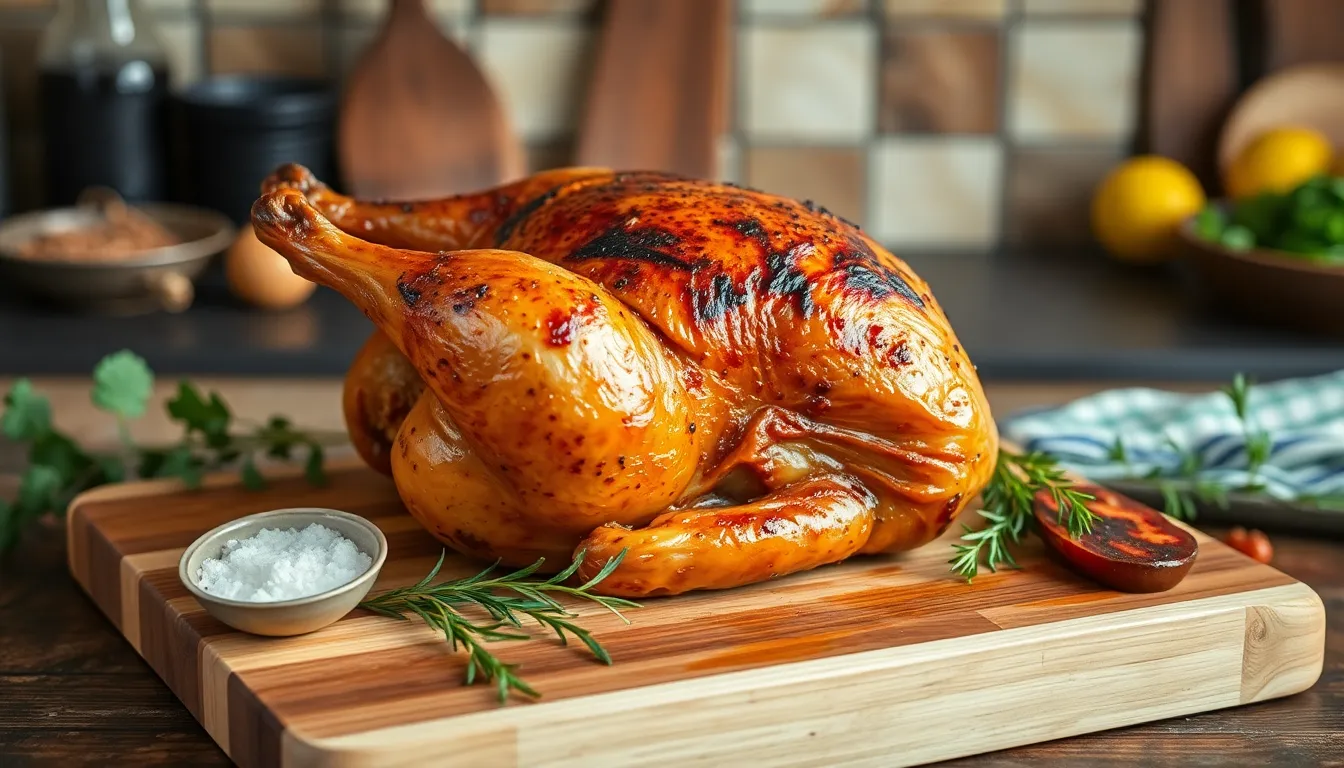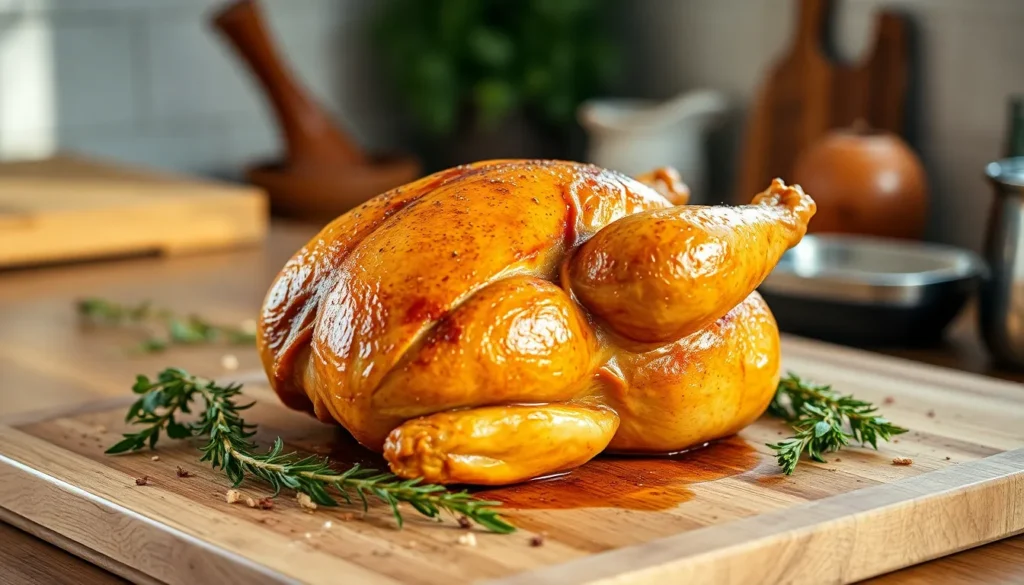Cooking chicken at 350 degrees might sound simple, but it’s a culinary dance that can leave even seasoned chefs scratching their heads. The secret lies in timing—too short, and you’re serving up a poultry nightmare; too long, and you’ve got a dried-out disaster. Nobody wants to chew on rubbery chicken, right?
Table of Contents
ToggleUnderstanding Cooking Times for Chicken
Timing plays a crucial role in cooking chicken at 350 degrees. Achieving the right doneness ensures safety and enhances flavor and texture.
Whole Chicken Cooking Times
A whole chicken typically requires about 20 minutes per pound when cooked at 350 degrees. A five-pound chicken takes approximately 1 hour and 40 minutes. To ensure safety, internal temperature must reach 165 degrees Fahrenheit. Resting for 10-15 minutes after cooking allows juices to redistribute, improving moisture.
Chicken Parts Cooking Times
When cooking chicken parts, times vary based on the specific cut. Breasts usually need 25 to 30 minutes, while thighs and drumsticks require around 30 to 40 minutes. Bone-in pieces typically take longer than boneless. Always check internal temperatures, aiming for at least 165 degrees Fahrenheit for safety and optimal flavor.
Factors Affecting Cooking Times

Cooking times for chicken at 350 degrees can vary based on several key factors. Understanding these elements ensures a flavorful and safe meal.
Size and Weight of Chicken
Size and weight significantly impact cooking times. A smaller piece of chicken cooks faster than a larger piece. For example, a whole chicken weighing five pounds generally requires about 1 hour and 40 minutes. Chicken breasts, being smaller, usually cook within 25 to 30 minutes, while thighs and drumsticks require about 30 to 40 minutes. Assessing weight allows for accurate timing and prevents undercooking or overcooking.
Oven Variability
Oven variability can further affect cooking times. Different ovens may not maintain consistent temperatures. Some ovens heat unevenly, creating hot and cold spots. It’s important to use an oven thermometer to check actual temperature accuracy. Additionally, adjusting for any differences in oven performance improves the chances of achieving optimal results.
Cooking Method
Cooking method plays a crucial role in how long chicken takes to cook. Methods like roasting and baking differ from grilling or frying. Roasting whole chickens at 350 yields moist, tender meat, while grilling may cook faster due to direct heat. Each method impacts final texture and flavor, necessitating adjustments in cooking time. Understanding the cooking method helps ensure chicken reaches the safe internal temperature of 165 degrees Fahrenheit.
Recommended Cooking Techniques
Achieving perfectly cooked chicken at 350 degrees requires attention to detail and some useful techniques. Several methods can help enhance chicken’s flavor and ensure safety.
Using a Meat Thermometer
A meat thermometer provides accurate readings of internal temperature. Aim for 165 degrees Fahrenheit to guarantee safety and avoid undercooking. Insert the thermometer into the thickest part of the chicken, avoiding bones for precise measurements. Regular checks during cooking allow adjustments for optimal doneness. Utilizing this tool reduces uncertainty and enhances cooking confidence.
Roasting vs. Baking
Roasting and baking differ in cooking techniques and outcomes. Roasting employs higher heat, promoting browning and flavor development, making it suitable for whole chickens. In contrast, baking often uses lower temperatures and is more uniform, ideal for chicken parts. Roasting creates a crispy skin, while baking may result in more tender meat, especially for breasts. Both methods yield delicious outcomes, depending on desired texture and preparation style.
Tips for Juicy Chicken
Achieving juicy chicken requires attention to detail in marinating, seasoning, and allowing for a proper resting period. These factors enhance flavor and moisture, leading to a more enjoyable dining experience.
Marinating and Seasoning
Using a marinade infused with herbs, spices, and acids adds richness. The combination of ingredients like olive oil, citrus juice, and garlic creates a depth of flavor. Aim for at least 30 minutes to 24 hours for optimal results. Allowing more time enables the flavors to penetrate the meat. Seasoning with salt and pepper right before cooking also enhances taste, ensuring the chicken remains juicy and flavorful. Consider including an acid in the marinade, as it helps tenderize the chicken while adding a bright note.
Resting Period After Cooking
Resting chicken after cooking is crucial. Allowing it to rest for 10-15 minutes redistributes the juices within the meat. Cutting too soon causes lost moisture, resulting in dryness. The chicken continues to cook slightly during this resting phase, ensuring it’s safely cooked through. Placing a loose tent of foil over the chicken helps retain heat while it rests. During this period, the flavors and juices meld, leading to a more succulent final dish.
Cooking chicken at 350 degrees requires attention to detail and a solid understanding of timing. By following the recommended cooking times and ensuring the internal temperature reaches 165 degrees Fahrenheit, anyone can enjoy juicy and flavorful chicken.
Utilizing techniques like marinating and allowing the chicken to rest post-cooking enhances moisture and taste. With the right approach and a bit of patience, achieving perfectly cooked chicken becomes an attainable goal for both novice and experienced cooks alike.







